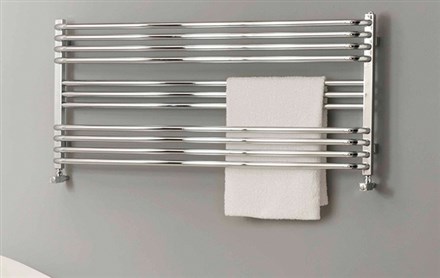It is undeniable that towel racks are the perfect tool to warm towels before taking a bath and, on the other hand, create a pleasant atmosphere and temperature in the bathroom, but how to choose one?
Choosing a precise towel warmer or heated towel rails for our bathroom should not be a complicated or exhausting task. Throughout its history, this device has gone from just air-conditioning the bathroom to preserve the environment and at present, add a plus of design, function that makes the space even more pleasant. Here we find that the specific towel rack is one that fits our needs.
The supply of heated towel rails is quite broad and with a rising demand. There are different types of systems among which we find those electric towel rails, radiators and finally those of advanced technology denominated of last generation.
Choosing a precise towel warmer or heated towel rails for our bathroom should not be a complicated or exhausting task. Throughout its history, this device has gone from just air-conditioning the bathroom to preserve the environment and at present, add a plus of design, function that makes the space even more pleasant. Here we find that the specific towel rack is one that fits our needs.
The supply of heated towel rails is quite broad and with a rising demand. There are different types of systems among which we find those electric towel rails, radiators and finally those of advanced technology denominated of last generation.
If what we are looking for for our bathroom has to fulfill its function before a saving in the space, the most simple option is the heated towel warmer. Although there are a multitude of types and styles of these devices, they are designed to be glued to the wall, with flat and simple shapes and also have the ability to heat or dry towels that can be hung around your tubes. Although they are powered by electricity, these systems are constructed in such a way that the expense of resources is minimal with an effective environmental functionality.
Although they seem the same system, the characteristics that differentiate the electric towel rails from the towel rails are obvious. Towel rails have a higher electrical consumption compared to the previous ones; However, the radiators have a function where it is possible to program them to turn off once the bath is at the desired temperature, unlike the previous system that may be left on, air conditioning 24 hours.
Finally, there are the latest generation towel rails, those that combine air conditioning, integral design, environmental care with low energy consumption and technological functions that make it much more practical than the previous ones. They can be electric, powered by a common plug or gas, which requires a more elaborate installation. Among the designs that start to surprise consumers are those devices that have applications such as connection and disconnection via sms, cooling and presence sensor, as well as fire alarm, among many other details.
In general, choosing the right heated towel rail NZ will be derived from the utility and need that is required, based on the design of the space where the device needs to be installed. Although the economic saving of this system is not fought with the functionality, it is necessary to know those characteristics that better adapt to improve our quality of life.



